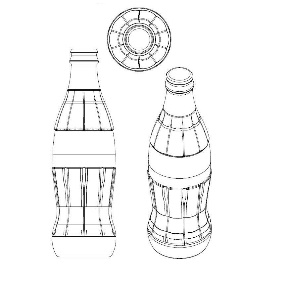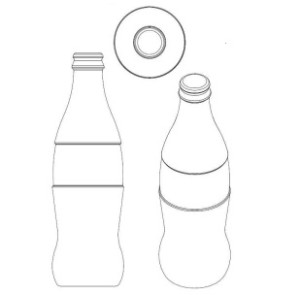On February 24, 2016, the General Court dismissed an action of the Coca-Cola Company and confirmed the decisions of OHIM and the Board of Appeal (case R 540/2013-2) by ruling that the known shape of the contour bottle of Coca-Cola without fluting lacks distinctive character and is thus not registerable as a 3D-Community trademark (GC decision of February 24, 2016, T-411/14).
The US multinational beverage corporation Coca-Cola is in the fortunate and privileged position of being the owner of a handful of registered 3D-Community trademarks showing the shapes of bottles, in particular the famous contour bottle with fluting:
 (CTM 010532653; registered for goods of classes 6, 21 and 32).
(CTM 010532653; registered for goods of classes 6, 21 and 32).
Even the application for protection of this bottle with fluting was initially refused by OHIM. However, the Board of Appeal finally found that “in particular, the presence in the bottle’s body of the flutes which cross the interrupted horizontal lines confers on the whole sign an appearance which is striking and easy to remember” (case R 525/2013-2, para. 26) and allowed the mark for Registration.
Coca-Cola failed, however, with its approach to achieve registration for a 3D-Community trademark consisting of the plain shape of its well-known contour bottle without fluting, as shown below:
 (CTM 010532687; registered for goods of classes 6, 21 and 32).
(CTM 010532687; registered for goods of classes 6, 21 and 32).
OHIM had already ruled in the previous instances that the applied-for 3D-mark lacks distinctive character. The decisions are primarily based on the argument that the mark only reflects a common shape of a bottle and, therefore, does not enable the relevant public to immediately and directly identify the commercial origin of the goods. Furthermore, it was argued that it cannot be assumed that the mark would constitute an evolution of the contour bottle with fluting since the fluting is actually the eye-catching element.
Coca-Cola had also submitted various documents in support of its further claim that the applied-for mark had acquired distinctiveness through use in the EU (Art. 7 (3) CTMR). These documents contained surveys conducted in 10 EU Member States revealing recognition rates between 48 % and 79 %.
The General Court confirmed the findings of the previous instances regarding the absolute grounds of refusal according to Art. 7 (1)(b) CTMR. It held that only a 3D-mark which departs significantly from the norms or customs of the sector and thereby fulfills its essential function of indicating origin is not devoid of any distinctive character. The General Court found that the present shape simply represents a bottle like the majority of the bottles on the market.
As to Art. 7 (3) CTMR, the General Court stated that it is necessary that at least a significant proportion of the relevant public identifies the goods or services concerned as originating from a particular undertaking. Although the Court explicitly pointed out that it would be unreasonable to require proof with regard to each individual Member State, it still found that the surveys conducted in only 10 EU Member States are not sufficient. According to the General Court, “the results of those services cannot be extrapolated to the 17 Member States in which no surveys were conducted” (para. 80), in particular as Coca-Cola did not demonstrate that certain Member State markets covered by the surveys are comparable to others.
When taking into account the tendency of the recent filing practice of OHIM with regard to three-dimensional trademark applications showing plain bottle shapes, the outcome as such is not surprising.
What is remarkable about it is the fact that the General Court ruled that distinctiveness of the mark through use has not been sufficiently demonstrated, although surveys were filed which had been conducted in 10 member states (including important global markets like Germany, France, Italy and the UK) and had provided convincing results. The decision does not state specifically in how many Member States such surveys would be necessary in order to provide sufficient proof. Would that be half of all Member States or even more? At present, it seems advisable to conduct surveys in as many Member States as possible to achieve a positive result or at least to demonstrate that certain Member State markets covered by the surveys are comparable to others. Since the situation still seems to be vague, it will be very important to keep an eye on how these requirements will develop in future.
_____________________________
To make sure you do not miss out on regular updates from the Kluwer Trademark Blog, please subscribe here.



Why haven’t they chosen to register this bottle as an utility model instead?